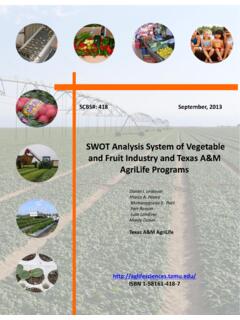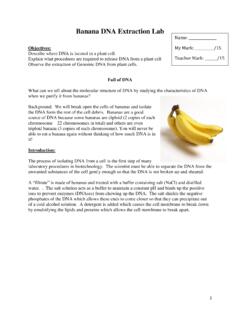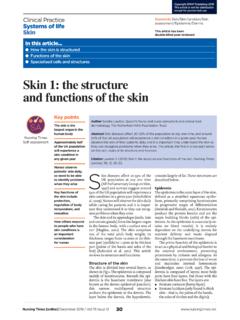Transcription of Virology Techniques - Texas A&M AgriLife
1 Chapter 5 - Human Health: Real Life Example (Influenza)1 Chapter 5 - Lesson 4 Virology TechniquesIntroductionVirology is a field within microbiology that encom-passes the study of viruses and the diseases they cause. In the laboratory, viruses have served as useful tools to better understand cellular mechanisms. The purpose of this lesson is to provide a general overview of laboratory Techniques used in the identification and study of viruses. A Brief HistoryIn the late 19th century the independent work of Dimitri Ivanofsky and Martinus Beijerinck marked the begin-ning of the field of Virology .
2 They showed that the agent responsible for causing a serious disease in tobacco plants, tobacco mosaic virus, was able to pass through filters known to retain bacteria and the filtrate was able to cause disease in new plants. In 1898, Friedrich Loef-fler and Paul Frosch applied the filtration criteria to a disease in cattle known as foot and mouth disease. The filtration criteria remained the standard method used to classify an agent as a virus for nearly 40 years until chemical and physical studies revealed the structural basis of viruses.
3 These attributes have become the ba-sis of many Techniques used in the field organisms are affected by viruses because viruses are capable of infecting and causing disease in all liv-ing species. Viruses affect plants, humans, and ani-mals as well as bacteria. A virus that infects bacteria is known as a bacteriophage and is considered the This electron micrograph depicts an influenza virus particle or virion. 4 - Human Health: Real Life Example (Influenza)most abundant biological entity on the planet. Many animal disease systems serve well as models for hu-man disease.
4 Many of the Techniques used in the study of viruses are the same whether they infect plants or warm- or cold-blooded creatures because the tech-niques are based more on the virus studied rather than the species affected. Viruses are considered obligate intracellular parasites since they require living host cells to replicate. Virus-es take over or hijack the cellular synthesis machinery in order to reproduce. Viruses are submicroscopic and contain either DNA or RNA as their genome and is enclosed in a protein shell called the capsid. Coded in the DNA or RNA genome of the virus is all the information needed for replication.
5 Some viruses also contain lipids , carbohydrates, and special enzymes that assist in their transmission and replication. Some viruses are enveloped; this envelope is acquired from the host cell either from the cytoplasmic or nuclear membrane . This outer coat is immunogenic, (what the immune system recognizes and what antibody pro-ducing cells respond to), and is necessary for the virus to invade a TechniquesSeveral different methods are used to study viruses and viral diseases, as the field is constantly changing with the discovery of new methodologies and tech-nologies.
6 This section will provide a cursory overview of the most commonly used Techniques in diagnostic Virology and will conclude with a brief glimpse of vi-rology in research. Diagnostic Virology is concerned with identifying the virus associated with clinical signs and symptoms. Procedures most commonly used include:1. Detection of a meaningful immune response to the virus (antibody or cell-mediated) by immuno-logic assay(s) 2. Identification of the agent by staining of speci-mens or sections of tissue (light and electron mi-croscopy)3. Isolation and identification of the agent (cell cul-ture or fertile eggs)4.
7 Detection of viral nucleic acid (probes or ampli-fication).Detection of Immune ResponseOften, it is difficult to identify a virus in relation to the disease observed, or when conducting a retrospective study of a population to determine exposure to a virus, or when measuring the response of an individual to a vaccine. In these cases, indirect methods of measure are needed, such as measuring antibody response to the virus of interest. Several methods exist for this purpose. A few of the most commonly used methods include: Virus neutralization (VN) Hemagglutination inhibition (HI) Enzyme linked immunosorbent assay (ELISA) Indirect fluorescent antibody (IFA) Complement fixation (CF) Agar-gel immunodiffusion (AGID) Agar-gel precipitin (AGP) Latex agglutination (LA).
8 The principles of these assays are fundamentally the same, they depend upon antibody-antigen interactions and consist of a known virus or viral protein, a patient sample (usually serum), and an indicator. If antibod-ies are present in the patient s serum, they will bind to the virus. If no antibodies are present, no binding will occur. The indicator is observed to determine whether the sample is positive or negative for antibodies. This illustration provides a 3D graphical represen-tation of a generic influenza viron s substructure. A portion of the viron s outer protein coat has been cut away.
9 Dan Higgins, 5 - Human Health: Real Life Example (Influenza)3 Virus NeutralizationIn the virus neutralization (VN) test, the sample of in-terest is incubated with the target virus and changes in cell culture are observed (called cytopathic effect, CPE). If the sample contains antibodies, it will prevent the virus from growing in the cell culture and no CPE will be observed. If no antibodies are present in the sample, the virus will grow and CPE will be observed. Hemagglutination Inhibition Certain viruses have a protein on their surface that in-teracts with red blood cells and is able to attach to them.
10 This property is called hemagglutination and the surface protein of the virus is hemagglutinin. The inhibition or blocking of this activity is the basis of the hemagglutination inhibition (HI) test. The most well known virus with this property is the influenza virus. Like the virus neutralization (VN) test, the pa-tient s serum sample is incubated with the virus of interest but instead of growing the virus in cells, red blood cells are added to the virus-serum mix. If anti-bodies are present, the hemagglutination activity will be blocked; if no antibodies are present the virus will agglutinate (bind together).











